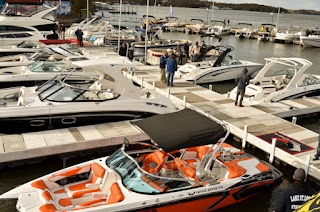Winter is Coming What To Do To Prepare Till Next Boating Season
There is a nip in the air, the leaves are starting to change color. It is time to start thinking about putting the boat away until next year.
The bad news about winterizing your boat is that if you forget something critical or you do something incorrectly, you may be faced with expensive repair bills and a long delay to get back on the water next spring. The good news is that most winterizing chores are not that hard, and we can show you how to avoid the vast majority of problems in a single page (though you'll want to download our winterizing guide for a much more in-depth look). In a nutshell, winterizing means storing your boat properly, making sure engines and drives are protected, and making the plumbing freeze-proof.
Taking a few moments now to think about how you'll put your boat to bed for the off season, as the days grow shorter and the ducks fly south, will pay dividends later. Whether this is your first or your 51st year winterizing your boat, all the know-how you need is available to you in "The Boater's Guide To Winterizing," a downloadable checklist to bring along to the boat with you. But before you go online, ask yourself a few questions:
Where (And How) Do I Want To Store The Boat This Winter?
This is the starting point for any winterizing plan. Options include everything from indoor heated storage, to in the water, or out back on the trailer under a tarp. Or perhaps you'd prefer to tow or ship your boat to Florida to use during a winter getaway? Other considerations include:
How secure is the location, be it a boatyard, storage lot, or private property? How accessible will it be? Who will transport the boat there?
How hard is it for you to personally check on the boat?
Who will perform any needed labor to winterize the boat? Does the yard place limits on DIY maintenance or outside contractors?
Will you cover the boat? If not, a first-rate wax job — and cleaning and polishing the stainless steel — will help protect it, but you need to add the time and cost to your plan. A good cover or shrink-wrap eliminates many of the issues with leaves or snow clogging cockpit drains, and other hazards of winter. Consider investing in a custom winter storage cover rather than paying for shrink-wrap each season.
What Systems Need to be Addressed?
Generally, anything that uses water for cooling or carries water for use on board, needs to be winterized. Fall is also the perfect time to do your annual oil change and transmission fluid, or lower-unit gear-lube change on your engines. Make sure your to-do list includes: Oil change and cylinder fogging for engines and generators.
Lower-unit gear-lube change for outboards or sterndrives.
Topping off the fuel tank, adding stabilizer or biocides as needed.
Draining or flushing/filling any raw-water cooling systems with nontoxic antifreeze. Don't forget the air-conditioning system.
Water system winterization, which can be draining or flushing or filling, depending on your preference. This includes tanks, heads, pumps, shower sumps, sinks, and even seacocks, if the hose runs don't drain entirely.
Inspection of anodes and running gear.
Washing the exterior of the boat to remove salt and dirt, and getting the cockpit or other exterior drains cleared.
Make sure batteries are fully charged, or better yet, remove them where they can be stored indoors and given a booster charge from time to time to keep them topped up.
What's Left To Do?
Your boating gear, and all the stuff a boat tends to accumulate over the season, will be more likely to stay clean, dry, and mildew free if you take it home and store it there. Additionally, gear that's not on the boat is gear that's not there to be stolen during those quiet months when the boatyard is largely empty. Consider:
Removing bracket-mounted electronics, even if they're in the cabin or pilothouse.
Taking big-ticket items, like the dinghy, outboard, or kicker off the boat. Same goes for paddleboards and large water toys you might store aboard.
Removing rods, reels, and tackle, which are a favorite target for thieves.
Taking home spare clothes, cushions, canvas awnings, bedding, life jackets, and anything else likely to mildew. Wash it all and make sure it's all salt-free and dry before storing. Put a lubricant on snaps and zippers, so they don't seize up over the storage season.
Adding a GPS tracker to your trailerable boat for remote monitoring. For as little as $99, it can keep an electronic eye on your boat when you can't.
Blocking your trailer up off the ground and removing the tires. This will not only deter thieves but also make trailer tires last longer.
How you answer these questions will dictate how much time, energy, and money you spend, and many of us gladly trade the latter for more of the former. Having a plan and preparing your boat well will mean getting back on the water sooner come spring.
Storage
The best place to store your boat is on land — winter storms or a failed thru-hull can't sink a boat that's not in the water. Cradles, jackstands, dry-stack storage, and trailers are your choices. Larger boats are usually stored ashore on jackstands. Make sure that the stands sit on plywood so they can't sink and that they are chained together so they can't slip away from the boat. If you store your boat on a trailer, you'll extend the life of the tires if you take the load off of them with blocks. It also makes it harder to steal your boat.
If you decide to store in the water, your job is to prevent thru-hulls from allowing water in (close all but cockpit drains), be certain your bilge pump works well (test it by putting some water in the bilge and letting the float switch actuate), and make sure your boat is tied so strong winds can't bang it against the dock (use long spring lines and have chafe guards on every line). Whether ashore or in the water, a well-fitting cover will prevent the cockpit from filling with water or ice during winter storms.
Once you've determined which method of storage works best for your boat, be sure to evaluate your boat insurance to make sure you're fully covered. Be aware that many storage facilities don't cover damage to your boat should a fire or roof collapse occur at the facility. Not all homeowner's insurance policies will cover the boat while stored at the residence.
Getting the Water Out
Fun fact: When water freezes, it expands by almost 10 percent. Not-so-fun fact: If your raw-water cooling system holds, say, 10 quarts of water, when it freezes, there will suddenly be an extra quart inside under great pressure, with nowhere to go. It's enough pressure to destroy a manifold, wreck a refrigerator, and even crack an engine block like an eggshell. The key, then, is to get water out of places where it will cause damage when it freezes.
Nearly all engines use raw water for at least some parts of the cooling system, and this water must either be drained or replaced with antifreeze. Mistakes in this step lead to the vast majority of the freeze claims in the BoatUS Marine Insurance files. Outboards can usually be drained easily simply by tilting the engine all the way down, but for inboards and I/Os the preferred method is to circulate antifreeze throughout the cooling system. Typically, a bucketful of antifreeze is sucked into the engine's raw-water intake, replacing the water. Sea strainers need to be drained or filled with antifreeze too, because ice can crack them open and sink the boat during a thaw.
Other areas that have a risk of freezing water and need draining or antifreeze include the potable water system, air conditioning and refrigeration systems, marine heads and holding tanks, and bilge-pump systems (if your boat is stored out of the water).
Other Winterizing Tips
- Change the oil in the engine and sterndrive or lower unit before laying up — this prevents old, acidic oil from damaging internal parts.
- Fog gasoline engines to protect against internal rust.
- Fill gasoline tank and treat the fuel with stabilizer, or completely drain to ward off ethanol-induced issues and stale gas next spring.
- Flush outboards and store in lowest position to prevent water from remaining inside and freezing.
- Remove expensive electronics and fishing gear, and store at home to prevent damage or theft over winter.
- Don't use a heater to winterize your boat. Not only will it prove useless right when you need it most (during a winter-storm power outage), there is a very real risk of fire.
- Visit your boat frequently to head off potential issues before they become serious.




Comments
Post a Comment